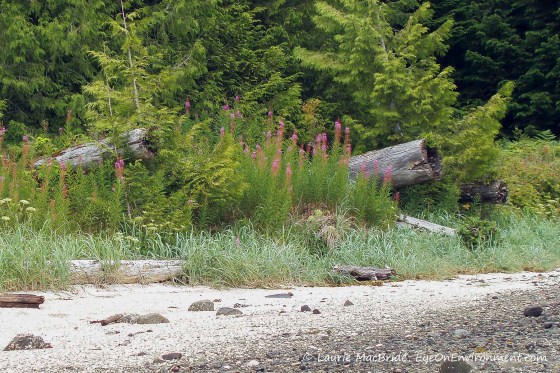Blunden Harbour forms a welcome haven on a long stretch of open, exposed coastline on the east side of Queen Charlotte Strait. Inside are extensive intertidal mudflats along with a huge tidal lagoon, a number of streams and miles of protected shoreline.
The ‘Nak’waxda’xw (Nakwakto) people who moved here in the 19th century from Seymour Inlet to the north must have thought they’d found paradise: plenty of fresh water; an endless supply of clams and other shellfish; a flat, low area above the beach for erecting homes; plenty of cedar and other building materials in the forest; and close proximity to rich fishing grounds.
In 1901, when Charles F. Newcombe photographed Blunden Harbour (the photo that later inspired Emily Carr’s famous painting), a long line of houses and totems stretched along a boardwalk street above the beach and harbour. Called Ba’as by its residents, this village was a culturally rich and vibrant place.
But by the 1960s everything had changed, and in 1964 the people of Ba’as decided to move to Port Hardy. They really had no choice, as the federal government threatened to close their school and remove all its support for housing and other services unless they relocated. And so the beautiful village of Ba’as died – killed by the Canadian government’s increasing push to amalgamate and centralize First Nations in fewer, more convenient locations.
Nowadays, almost nothing remains: the forest and wild flowers have overgrown the area where the boardwalk, totems and homes once stood. Only a couple of fallen house posts and a long white shell midden mark the site of this once important coastal village. Looking at them, I visualize Emily Carr’s painting and think about the vibrant community that once lived here, and all the life and promise that this beautiful place must have held.
We’re off the grid for most of the summer, with only occasional access to the internet. I welcome your comments, but it might be awhile before I can reply.


[…] Nations Nakwaxda’xw community had a thriving village the elders call Ba’as that was destroyed decades ago. A very sad story but gives great insight into how we can better handle relations with our […]
but gives great insight into how we can better handle relations with our […]
Did they save those wonderful greeting figures that we the subject of Carr’s painting?
I’m not sure, but I rather doubt they still exist. A lot of early art and cultural artifacts were taken by anthropologists and placed in museums in the US and Europe, but I haven’t been able to find any reference to these particular totem poles (other than photographs of them from around 1900). I don’t know how old they might already have been at that time, but I expect they are now long gone. Thankfully, there are a number of photos of them online, as well as Emily Carr’s painting.
HI there, I’m a new follower to your blog. I’ve just had a trip up in this area and was fascinated by Blunden Harbour. It is so beautiful but has such a sad history. thank you for the blog posting. May i refer to it in mine? Thanks, LIndley
Thanks Lindley, and yes, by all means – you’ll find my policy re: use of my material at the bottom of the left column on any of my blog pages.
I’m surprised to read that the village was abandoned as late as 1964. I was there in a boat in about 1978 for 5 days getting out of the weather, and it looked then like no one had been therel since 1900. Thanks for your information. George.
Thanks for the visit and comment, George. I agree, it looks like it’s been abandoned longer than this. I’ve noticed this in other places on the coast, too – in our rainy climate, the forest moves in very quickly and pretty soon it’s very hard to tell that there was ever a settlement there.
Hi Laurie – what a nice place this is. I wish I could visit it some time. And maybe I will – who knows. Here is a link to Newcombe’s photo: http://bit.ly/OMJqxB
Thanks so much, ehpem, I’ll check it out. Blunden is a special place, for sure. And this summer, for the first time we managed to make it into Bradley Lagoon (which flows into Blunden) in our kayaks. We had tried a couple of times in past years, but the tidal rapids were always running way too fast. This year we managed to figure out when slack would be and went in and out without mishap. It’s a huge lagoon – we only saw a small bit of it as we were paddling…you would need a high-speed inflatable to see much of it within the short time of slack.
That sounds like a great time in the lagoon – I suppose one could camp in there and explore at some leisure, but not if a boat is left anchored elsewhere, untended.